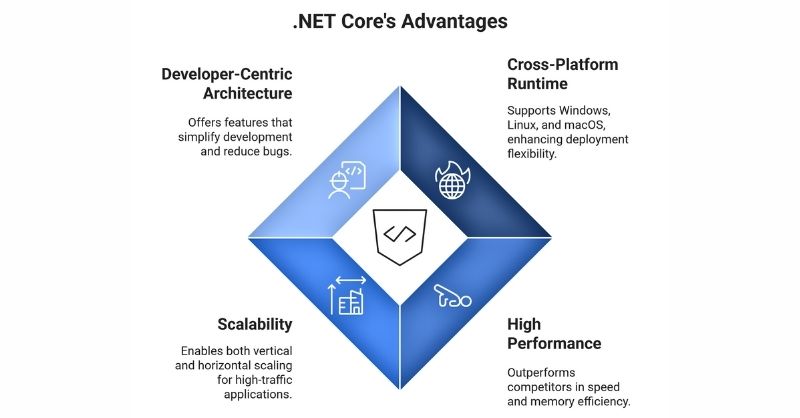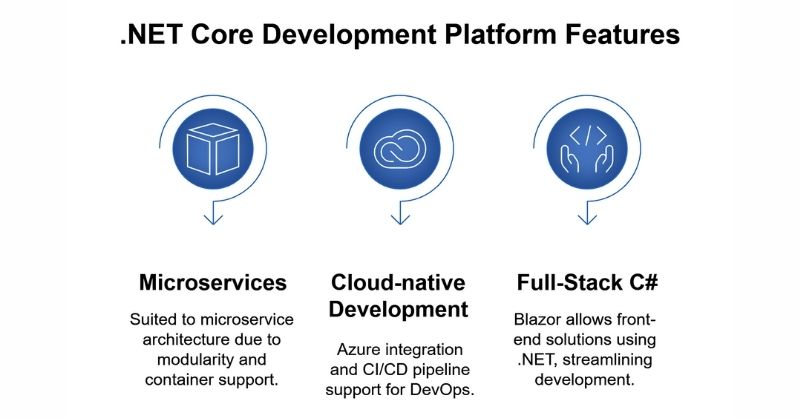- June 17, 2025
Why .NET Core Is Quietly Becoming the Backend Framework of the Future
With the bewitching cloud-native, higher-performance, and cross-platform requirement, modern applications have applied utmost pressure on the backend development frameworks.
Among the many choices of frameworks available, in silence, .NET Core has almost become a favorite of enterprises willing to transform their backend systems.
With a strong base in open-source development, performing high-speed, and enabling easy scalability, it has everything that today’s distributed architectures need, making several industry leaders reconsider why use .NET Core as strategic backend framework.
This blog talks about the key reasons for the growing popularity of .NET Core, examines its key strengths and real-world implementations, and talks about how .NET will dictate the future of back-end development.
Come, join us in exploring this article!!
The Shift Towards Modern Backend Architectures

There are no longer great big, tightly coupled applications that exist on-premises in the modern rear end. A new paradigm has come forth, defining a new future for backend development that includes:
1. Migration from Monolithic Structure to Microservices
Monolithic architectures are very difficult to scale and nearly impossible to update without breaking something along the way. Due to the new .NET Core capabilities, organizations are moving into microservices, which are loosely coupled services that can deploy on their own and be more manageable.
2. Increased Expectations of Cloud-Native
With hybrid and multi-cloud rapidly becoming the norm, backend services must be designed with cloud readiness in mind. Cross-platform capability is found in the .NET Core framework, which allows the deployment of services to Linux, macOS, and Windows environments, making this the natural candidate for cloud-native .NET Core architecture.
3. Backend Agility and Performance Pressures
Being fast underperformance conditions is everything else but standard. Quickly responding to market demands without neglecting speed from agile teams that can build high-performance and scalable solutions without asking any less if they want an easy iteration process.
4. Modernization beyond Just Web
They do not stop at web applications, though. Today’s backend systems include APIs, IoT services, mobile backend logic, and much more. Enterprise-level modernization strategies for the backend have called for the backend to adopt a more flexible service-oriented framework, which is the exact area in which .NET Core excels.
Core Advantages That Make .NET Stand Out

Why use .NET Core? What are the factors that make it an attractive option for enterprises when it comes to their backend workloads? These are the highlights:
a. Flexible Cross-Platform Runtime
It is Windows, Linux, and macOS that natively operate .NET Core, making the deployment easy across those infrastructures. For businesses with mixed environments, flexibility brings cost savings and agility in deployment.
b. High Performance Execution Engine
In the area of high-performance execution engines, .NET Core has outperformed several of its competitors, although whether it be latency sensitive APIs or heavy data processing, benchmarks have shown that it provides better performance than Node.js and Python frameworks in both throughput and memory efficiency making it the best candidate for scalable backend applications.
c. Horizontal and Vertical Scaling Features for High-Traffic Applications
Apps built with .NET Core have the capability of scaling both vertically and horizontally, regardless of the industry-fintech, e-commerce, and the likes. The asynchronous programming model and integrated support for containers and Kubernetes make modern applications-built track with .NET Core to scale.
d. Modern Developer-Centric Architecture
The architecture is designed around the developer, providing features such as dependency injection, built-in logging, and one unified programming model. This makes working with .NET Core easy, speeding up time-to-market and reducing production bugs.
Flexible Development Across Applications and Platforms

.NET Core is, after all, much more than just a back-office workhorse; it is an all-around development platform:
a. Microservices and Distributed Systems
Thanks to its modularity, lightweight run-time, and container support, .NET Core lends itself perfectly to the microservice architecture. An organization adopting microservices on .NET Core would experience complete service separation, accelerative deployment cycles, and simplistic maintenance.
b. Cloud-native Development Practices
This is a popular trait of .NET Core: azure-native integration, CI/CD pipeline support, and container functionality out-of-the-box. It is a strong cloud-native development choice. Organizations leveraging cloud-native .NET Core solutions appreciate how easily it fits into their DevOps pipelines.
c. Full-Stack C# with Blazor
This means that with Blazor, .NET can now be tapped to implement front-end solutions; thus, Blazor should now be able to perform full stack using C#. One doesn’t have to refer to a separate framework in JavaScript, and one can do both coding in one tongue instead of in two, thus streamlining recruitment, onboarding, and maintenance of code.
Long-Term Technical and Business Sustainability
Beyond the immediate characteristics of .NET Core, it really gives you amazing benefits for the long run:
a. Open-Source Innovation Driven by Community
Unlike its predecessor, .NET Core is entirely open source and has a very active and glowing global developer community. The open-source .NET Core adoption model gives constant and immediate innovations and bug fixes, both for small teams and for large enterprises.
b. Entry-Level Use Case Maturity for Enterprise
For banks and logistics companies, enterprise backend modernization comprises replacing legacy .NET Framework substructures with newly developed .NET Core services that increase flexibility, performance, and integration into the cloud.
c. An Array of Tools and Wide Ecosystem
Supported by a huge set of tools like Visual Studio, GitHub Copilot, Azure DevOps, and Entity Framework Core, .NET Core builds on its modern app development .NET Core ecosystem to smoothen everything from code to deployment.
Comparative Strengths and Real-World Implementations
Comparisons with Java, Node.js, Django:
Java: Great for large enterprise systems but a bit verbose, heavier on runtime memory.
Node.js: Lightweight, for real-time apps but falls short on CPU-bound operations.
Django: Great for rapid development, but performance drops with traffic.
In comparison, .NET Core balances performance, readability, and developer experience; hence it’s a jack of all trades.
Use Case Scenarios for Various Industries:
Healthcare: Scalable API for patient data and telemedicine services.
Finance: Fast processing of transactions with strong security.
Retail: Omnichannel inventory- and order management systems.
At this point, such use cases prove increasingly relevant for .NET Core as digital maturity grows.
When .NET Core Is a Better Fit:
If in-house staff has C# talent.
If an architecture is needed that can scale and can be run in containers.
If high performance and enterprise-grade security are required.
The Continuing Evolution of the .NET Core Platform
Microsoft continues pumping money into .NET core.
1. Single Model Development across Desktop, Mobile, and Web.
2. Cloud-Native Support Improved.
3. Diagnostics and Observability Tools Upgraded.
Native AOT and Performance Improvements:
This ultimately brings Ahead of Time (AOT) compilation to the field, which would dramatically decrease the startup time and memory usage-the big savior for microservices.
The better compatibility with Microsoft Platform Vision:
.NET Core is thus at the center of the future of Microsoft itself, that is Azure, Power Platform, and GitHub integrations into .NET Core. It guarantees that .NET Core will be relevant and is aligned with the ecosystem in the long-term future.
Conclusion
.NET Core is not an alternative anymore; it is now the preferred option for creating modern scalable cloud-ready backends. With cross-platform support, performance efficiency, and a broadening ecosystem, the reasons for more and more organizations picking it up are evident. If you are planning an upcoming back end, consider states on why use .NET Core.
Happy Learning!!
FAQs
1. What is the difference between .NET Core and Framework .NET?
.NET Core is a cross-platform, modern, open-source technology for developing applications, as opposed to being just Windows-borne like .NET Framework. Its features dedicate and optimize it towards scalability, containers and cloud.
2. Is .NET Core good enough to develop highly scalable web applications?
Definitely. With the runtimes that are high-performance and asynchronous programming supported, .NET Core is by nature meant for highly scalable web APIs and microservices.
3. Can legacy .NET Framework applications be moved to .NET Core?
Yes. This migration process is supported by tools and guides from Microsoft. There is a degree of effort that needs to be made, but by far the potential gains in performance and maintainability are high.
4. How does .NET Core facilitate the speed in which enterprises undergo experiential digital transformation?
.NET Core removes a lot of the friction in traditional enterprise development by rapid application development, cross-platform working, and integrated cloud support.




